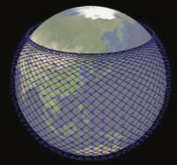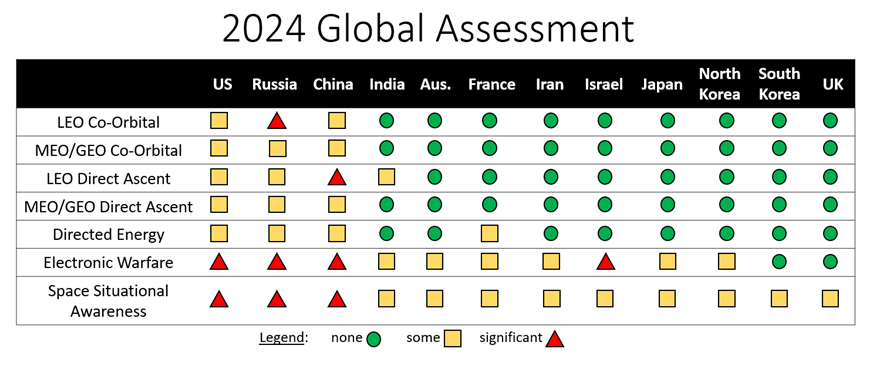The Lagrange points: The new Space Race.
In 1957, the Soviets shook the world when they sent Sputnik into orbit. The first artificial satellite was communist!
For 22 days, the USA looked at the sky in shame and anger. How could they have beaten America, the most powerful nation on Earth?
This event, and the many firsts the Soviet space program accomplished, triggered the most ambitious and most expensive program ever launched, the Apollo program.
It had one public goal: to land an American on the Moon and bring him back.
But the real objective was for the military to learn and master a new medium, space.
For 30 years, both superpowers were interlocked in a competition to design rockets powerful enough to launch thousands of nuclear warheads towards their enemy. This equilibrium of terror called MAD, for Mutual Assured Destruction, was a nuclear status quo accepted by both parties. A war never to be fought, because it had no winners. But on the back of this race, the space-exploring nations had to develop several technologies for these objects to be able to navigate across this new medium.
There are no borders to protect up there, but as in every battlefield, it has a specific topography, with orbital trajectories, choke points and a new high ground for military operations, the Lagrangian points.
New battlefield, new rules
To understand what we can do in space, one needs to understand a few sets of ground rules.
Forget Star Wars
The WW2-inspired dogfights are only possible where the atmosphere is dense enough to create lift and drag. Unlike an airplane, 90% of the mass of a rocket is its propellant, used to reach enough speed to leave the atmosphere and reach orbital velocity. The fuel left needs to be used carefully for the spacecraft to achieve its mission. A spacecraft does not use the afterburner for looping or barrel roll to intercept other rockets. The engine is used to maintain or change orbit (higher or lower) or slow down for re-entry. Yes, Top Gun in space would be boring.
Weapons do work in space
Again, new rules apply. Kinetic and explosive weapons have been tested, but the results were catastrophic.
In 1962, the US detonated a 1.45-megaton nuke in orbit during the Starfish Prime experiment. It generated an electromagnetic pulse that destroyed 30% of all the satellites in orbit, friend or foe.
Nobody noticed then, but today our life is driven by silicon chips that are extremely sensitive to high-energy bursts. With 9000+ satellites in orbit, a detonation would send us back 60 years.
The only good outcome was that it forced the US and USSR to talk and sign an agreement not to use nukes in space again.
During the Cold War, satellites were an integral part of the nuclear deterrence early warning system, so messing with them was an automatic declaration of nuclear war.
Kinetic or regular explosives can be used, but if a satellite is hit, the debris field generated will stay in the same orbit potentially for decades, making the orbit unsafe for everyone.
Part of Reagan's Star Wars Initiative, the “Brilliant Pebbles” program planned to deploy thousands of small satellites to destroy ballistic missiles by impacting them at high speed during their ascent. Too expensive, too complex and too late, the program was killed in 1993.
The 2013 film Gravity is the most vivid example of what space debris can do. But it had little effect on the collective wisdom, as since its release, no less than 4 satellites were destroyed by China, Russia and India during Direct Ascent Anti Satellite missile tests.
The 2007 Chinese test, was the most irresponsible, creating more than 3500 high-speed debris, forcing the ISS crew to prepare for potential evacuation. Half of these debris is still being tracked today, moving around the Earth at high speed….
https://swfound.org/counterspace/
Several countries have created a dedicated “Space force”
The US Space Force soldiers name themselves “the Guardians”, and they have 2 unmanned shuttles, the X37 B. She can stay years in orbit, grab friendly satellites to refuel, change their orbits and maybe even repair them. And she can also neutralise enemy satellites with lasers or microwave weapons.
X37B longest mission 908 days
The Russians are making the headlines in space, with some potential nuclear-powered or armed satellite projects.
Nuclear-armed platforms scare everyone, considering the current Russian leadership, but the nuclear-powered satellite is also something to worry about. Russia would own a satellite with enough potential energy to power lasers or microwave weapons, a more effective and debris-free way of disabling enemy satellites.
China also has its unmanned spaceship called Shenlong ("Divine Dragon") a space station and a moon landing project. The Chinese space program is now more advanced and better funded than Russia’s, whose international grandstanding is inversely proportional to their real capabilities.
Shenlong ("Divine Dragon")
https://swfound.org/counterspace/
12 countries have significant space capabilities, half of them with kinetic and or directed Energy weapons.
LEO, MEO, GEO and HEO
If you want to put a payload in space, you need to park it in a stable orbit, so it can stay up for several years.
Low and Medium Earth Orbit (LEO/ MEO) are ideal for communication, navigation and intelligence-gathering tools. Objects there need a high velocity to maintain their orbit, so they go around the Earth in around 90 mn. One additional problem here is because they are so close, what remains of the atmosphere slows them down. This is why objects on LEO, like space stations, need regular refuelling as they need to use their engines often to counter the small atmospheric drag.
All space stations are at this Orbit.
Geo stationary orbit (GEO) is useful when you want a fixed satellite relative to a point on Earth. Civilian TV or meteorological satellites are the most common.
A highly elliptical orbit, (HEO), allows a satellite to fly over every point on Earth once a day. It is quite useful to take a picture of a shiny new Chinese aircraft carrier, for example.
Orbits are like airline routes. They need some supervision to avoid accidental collisions.
We have today 9900+ registered active satellites in orbit and a few thousand retired ones.
The recent interest in Space from private ventures triggered a massive cost-reduction exercise.
The vast majority of launches today are low-cost, high-tech microsatellites sent by the dozens.
They are advantageously complementing the old big expensive and easy-to-neutralise military satellites as numbers offer redundancy.
We saw recently in Ukraine how the Army managed to quickly restore their communication with the Starlink civilian network, after being disconnected from the US-managed KA-SAT network, hacked by the Russians on the day of the invasion.
Planetary defense is a reality!
The military is mainly looking for threats coming from other countries on Earth, but not only, some money is used to scan for possible planet-killer asteroids. So far, a few thousand are known to exist, but none have been tagged with an impact date. We even tested a way to move them out of the way if necessary (Dart asteroid mission).
The joke is, that if the dinosaurs had a space program, we would not exist.
Let's be smarter!
(Source Oxford Departement for Continuous Education)



What about aliens? Well, yes we are searching, but space being so vast, it might take us a long time to notice anyone. And if we do, it might be safer for us to keep it quiet. If they have the technology to come over, they might take over.
If you believe in the dark forest hypothesis, the advice is, for us to survive, we must shoot first if we can, or stay hidden.
The new high-ground
On every battlefield, military leaders are looking for a vantage point, a high ground, difficult to reach, but with specific attributes giving an edge to whoever can control them.
In space, they are called the Lagrangian points.
Joseph Louis Lagrange is an Italian-born, French-naturalised scientist, who calculated 5 positions in space of gravitational and centrifugal forces equilibrium in a 2-body system (Earth + Moon for example).
Lagrange Points definition (Source Oxford Departement for Continuous Education)
A ship or a space station parked on Lagrange points can maintain its position with little or no fuel usage and will follow the rotation of the Moon/Earth around the Sun.
Lagrange's points are much farther away from Earth than GEO orbits. The L2 point is at 1.5 million Km. Objects that far, are more difficult to detect and are today out of reach of current weapons systems.
For the Earth/ Moon systems, the L1 point can be used as a refuelling station or shipyard on our way to the Moon or Mars.
Several scientific satellites are parked on Lagrange points, the James Web (in L2) being the most recent, but China Space Force has already sent several communication satellites there, to monitor their moon landing.
Each planet in our solar system has 5 Lagrange points with the Sun; Earth/ Sun, Saturn/ Sun etc.
So, with 7 planets, I exclude Mercury because of its proximity to the Sun, we have at least 35 L points that could be of use during our future and the inevitable expansion within our solar system.
Best-case scenario, we will use them as refuelling stations. Worst case scenario, that’s where the next battle station will be built.
The US Space Force created the 19th squadron in April 2022, with its first mission in deep space; to protect and defend the Earth/Moon Lagrangian points.
The United States Congres Select Committee, dedicated to the US / China space confrontation is unambiguous:
"Fund NASA's and the Department of Defense's programs that are critical to countering the Chinese Communist Party's malign ambitions in space, including by ensuring the United States is the first country to permanently station assets at all Lagrange Points."
So Death Star it is.
The race is on
General John Shaw, a former deputy head of Space Command, talks about “the third space age”.
With new players, India, China and many non-government companies now offering low-cost access to space, we are witnessing an acceleration in the number of launches (197 in 2023).
They offer their customers redundancy and high bandwidth for military and civilian uses (nuclear deterrence, combat cloud, natural disaster, weather, etc.).
The first shot of any confrontation would certainly start with an initial strike towards the enemy satellite network. An Army with assets positioned on Lagrange points would gain a significant strategic advantage.
Let's hope current leaders will be as wise as their mentors, and they will find the time to sit down and sign non-aggression agreements, so we can focus on scientific discoveries and explore our solar system for the benefit of all.
sources:
@SWFoundation: global counterspace threat assessment:
https://swfound.org/counterspace












